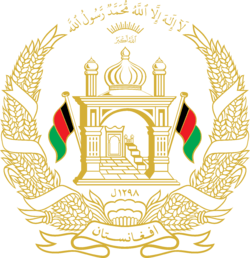Bonn Agreement (Afghanistan)
 |
| This article is part of a series on the politics and government of Afghanistan |
|
Legislature |
|
Judiciary |
| Foreign relations |
The Bonn Agreement (officially the Agreement on Provisional Arrangements in Afghanistan Pending the Re-Establishment of Permanent Government Institutions) was the initial series of agreements passed on December 5, 2001 and intended to re-create the State of Afghanistan following the U.S. invasion of Afghanistan in response to the September 11, 2001, terrorist attacks. Since no nationally agreed-upon government had existed in Afghanistan since 1979, it was felt necessary to have a transition period before a permanent government was established. A nationally agreed-upon government would require at least one loya jirga to be convened; however, in the absence of law and order in the wake of the rapid victory of American and Afghan Northern Alliance forces, immediate steps were felt to be required.
Overview
In December 2001, 25 prominent Afghans met under UN auspices in Bonn, Germany, to decide on a plan for governing the country (see list of signatories at International Conference on Afghanistan, Bonn (2001)). By inviting warlords capable enough to disrupt the state building process, a "big tent" strategy was enacted in order to incorporate, rather than alienate, these non-state actors in Afghan state centralization.[1] As a result, the Afghan Interim Authority (AIA) - made up of 30 members, headed by a chairman - was inaugurated on 22 December 2001 with a six-month mandate to be followed by a two-year Transitional Authority' (TA), after which elections are to be held.
One of the sections of the Bonn Agreement[2] envisaged the establishment of the International Security Assistance Force (ISAF).[3] Resolution 1386 of the United Nations Security Council subsequently established ISAF.
State building in Afghanistan
Following the fall of the Taliban in 2001, the Bonn Agreement laid the foundation for U.S. and NATO-backed state-building efforts in Afghanistan. The agreement sought to establish a new constitution, an independent judiciary, free and fair elections, a centralized security sector, and the protection of rights of minorities, including women and religious and ethnic groups. This model for state-building in Afghanistan was based on a ‘maximalist model of post-conflict reconstruction’ that surfaced in the 1990s, following international interventions in the Balkans, sub-Saharan Africa and East Timor.[4]
The Bonn Agreement provided a framework for the later constitution that was established in 2004 and the presidential and parliamentary elections that followed. It emphasized the need for strong, centralized government institutions and failed to account for the state’s cultural and political history, as the country had previously relied on informal, regional power structures to deliver security and services.
The state-building roadmap that was created by the Bonn Agreement was an inappropriate model for the Afghan case, and later led to a range of issues, including government corruption and incompetency. The subsequent failures of the Afghan state, including the inability to provide basic security and social services, stemmed from the ‘overambitious reconstruction model’ that was created by the Bonn Agreement, as well as practical challenges on the ground.[5]
Constitution of Afghanistan
Under the Bonn Agreement the Afghan Constitution Commission was established to draft a new constitution in consultation with the public. The Bonn Agreement called for a loya jirga to be convened within 18 months of the establishment of the Transitional Authority and for the use of the 1964 constitution as the basis for a new constitution. The constitution had been adopted by the loya Jirga on January 4, 2004.
Legal system
The Bonn Agreement calls for a judicial commission to rebuild the justice system in accordance with Islamic principles, international standards, the rule of law, and Afghan legal traditions.
Judicial branch
The Bonn Agreement called for the establishment of a Supreme Court of Afghanistan.
See also
- Bonn Conference
- International Conference on Afghanistan, London (2010)
- List of international conferences on Afghanistan
References
- ↑ Mukhopadhyay, Dipali (2014). Warlords, Strongman Governors, and the State in Afghanistan. Cambridge University Press. p. 26. ISBN 9781107595859.
- ↑ United Nations Security Council Document 1154. Annex I - International Security Force S/2001/1154 page 9. (2001) Retrieved 2008-08-26.
- ↑ United Nations Security Council Resolution 1386. S/RES/1386(2001) 20 December 2001. Retrieved 2007-09-21. - (UNSCR 1386)
- ↑ Mukhopadhyay, Dipali. "Warlords as Bureaucrats: The Afghan Experience." Carnegie Middle East Programme 101, Carnegie Endowment for International Peace (2009): Web.
- ↑ Mukhopadhyay, Dipali. "Warlords as Bureaucrats: The Afghan Experience." Carnegie Middle East Programme 101, Carnegie Endowment for International Peace (2009): Web.
External links
- Text of the Bonn Agreement 2001, UN Peacemaker
- Text of the Bonn Conference Final Declaration 2011, UN Peacemaker
- Text of all Peace Agreements for Afghanistan, UN Peacemaker
- Agreement on Provisional Arrangements in Afghanistan Pending the Re-Establishment of Permanent Government Institutions (Bonn Agreement), Council on Foreign Relations